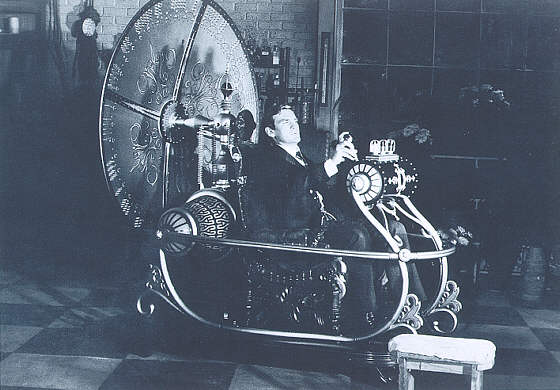Hochschule Augsburg
NTP Service
Realization
H. G. Wells published his famous book "The Time Machine"
in 1895, conceiving time as the fourth dimension and imagining
journeys to the future and the past. The picture is from a 1959 movie.
Computer
Old but useful! Long used PC components
are assembled in new boxes:
- Baby AT board with ISA bus
- i486 25/33/50 MHz and 8/16 MB RAM
- IDE and RS232 interface card
- IDE harddisk 200 MB / 1.2 GB
- NE2000 compatible Ethernet adapter
This hardware ist fast enough to run the NTP deamon
with a radio clock receiver attached.
The RS232 interface interrupt latency is acceptable.
We started with the slow 25 MHz 8 MB 200 MB machine.
Not much later followed the 33 MHz 8 MB 200 MB machine.
After a while my retired PC (50 MHz 16 MB 1.2 GB) was
reactivated to test run NTP version 4.
Software
For the low cost PC hardware Linux is
a natural choice as operating system.
First we installed the distribution of
Red Hat Software, Inc. via the Net
(FTP or NFS), but other distributions
are as good as this. Currently the
server is running under
SuSE Linux 5.2 from CD-ROM.
The
ntpd software distribution is
prepared for Linux. The current version will
install smoothly, though the former versions
required minor patches for the DCF77 receiver.
To start without problems we took the patched
xntp distribution from
Stephan Seidl (no longer available).
He installed the NTP service
in the university computing centre
(
ZIH)
of Dresden Technical University
(
TU Dresden).
At last we installed xntp3-5.93-export with
the generic parse clock driver compiled in
and all others excluded (no problems).
Setup
First time we set up our campus NTP service
following Stephan Seidl's excellent
guide.
Unfortunately, this page is no longer available.
You may install and setup a NTP client according to another
recipe.
Our
configuration file was adapted to our
network addresses and our DCF77 receiver.
The time offset between the DCF77 pulse
and the system time is 271 milliseconds
due to the receiver and the slow 25 MHz PC.
Stephan Seidl must have had an i486 50 MHz.
A correction of the system clock tick is
required. The tickadj value of 10004 was
found out by trial, using Frank Kardel's
special raw DCF77 receiver deamon dcfd.
After it was run
for a while, the value was computed from
the ntp.drift file. There is a Perl script
named
calc_tickadj in the xntp distribution.
The remaining drift value was about 12 ppm.
The offset between true time and system time
was in a range of +5/-6 milliseconds with
about 70% within ±3 milliseconds.
That's a nice result for such a cheap system.
Running
The xntpd daemon is started and halted
automatically by a
start/stop script at the end of the
boot sequence or at the beginning of the
halt sequence, respectively. The same script
is used to halt and restart the daemon
to trim the log file to smaller size.
Shortly after the hour an entry in /etc/crontab
calls: 'clock -wu'
This will set the internal (hardware) clock
to correct time. The -u is needed since our
system clock is running at UTC (not local time).
In the early morning hours of every day
cron runs a script to process the xntpd
statistics files which are written at the
end of each day. Actual graphics files are
written to a WWW directory and old files
are deleted or shrinked.
Receivers
For our purposes a low cost DCF77 receiver
is by far sufficient. There are very low cost
kits, but the soldering work doesn't pay.
In 1993 I purchased an 'Expert mouseCLOCK'
passive raw DCF77 receiver. The software
delivered with it is good, but not needed for NTP.
'Passive' means that there is no power supply.
The receiver is attached to a RS232 port and powered
by positive DTR and negative RTS line voltage.
'Raw' means that there is no processor.
The secondly time signals are received
at the RxD line and interpreted by software.
The Fachhochschule owns another DCF77 receiver,
an 'IGEL:clock'. It is passive and raw too,
but it comes with an additional RS232 adapter.
Usually raw DCF77 signals are received at a rate
of 50 bps. The adapter transforms the signals
to a shorter duration to be received at 1200 bps.
The intended effect of the adapter may be to get
more precise time signals.
Unfortunately, in our configuration this effect
is missed, perhaps because the PC hardware is too slow.
In any case, our NTP server runs more accurately
if only the receiver without the adapter is used.
Moreover the 'IGEL:clock' receiver turned out
to actually be an 'Expert mouseCLOCK'.
It is now used without the adapter on our second server.
If you intend to purchase a receiver of your own you should
have all relevant information to make the right choice.
Here are some
about our receivers and their vendors.
2003-06-22

